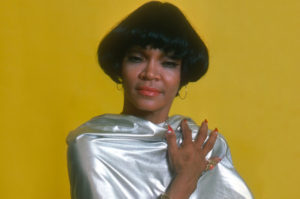 “LA LUPE”, IRREVERENTE, AGRESIVA E INOLVIDABLE CANTANTE CUBANA.
“LA LUPE”, IRREVERENTE, AGRESIVA E INOLVIDABLE CANTANTE CUBANA.
Lupe Victoria Yoli Raymond, mas conocida en el mundo artistico como “La Lupe” o la “Yiyiyi”, nació el 23 de diciembre de 1936 en el barrio santiaguero de San Pedrito.
Su padre trabajaba en la destilería local de Bacardí y tuvo una gran influencia en sus primeros años de vida. En 1954 participó en un programa de radio que invitaba a los fanáticos a cantar imitaciones de sus estrellas favoritas. Lupe escapó de la escuela para cantar un bolero de Olga Guillot, llamado “Miénteme”, y ganó la competencia.
La familia se mudó a La Habana en 1955, donde se matriculó en la Universidad de La Habana para convertirse en maestra. Ella admiraba a Celia Cruz y, como ella, se graduó de la enseñanza de la enseñanza antes de comenzar su carrera profesional de canto.
Tiempo después y establecida en La Habana, Lupe fue poco a poco colándose en el gusto popular entre rechazos y malas miradas. O enfrentando los calificativos de “loca” y “perturbada”. ¿La razón? Su forma de cantar: despojada de todo tipo de prendas, zapatos y acompañando esto de gemidos y golpes. Según Helio Orovio, en declaraciones para el documental Queen of Latin Soul, dirigido por Ela Troyano, al descargar, al parlar, al hablar, La Lupe “era una especie de rapera anticipada (…) La música iba por un lado y ella por otro, pero te dabas cuenta que todo aquello tan incoherente tenía coherencia y en medio de eso estaba el mundo gay. Ella era muy femenina y al mismo tiempo era macho, agresiva, irreverente.
El músico y compositor Rodulfo Vaillant fue uno de los que en Santiago de Cuba vio ir y venir a aquella mulatica “salsosa”.
Cada día son más los que en Cuba desconocen su vida, sus triunfos o su “conversión” de la religión yoruba al cristianismo. Más allá de su vida azarosa, La Lupe se instauró como una de las divas inigualables de la música cubana y, como otras, sufrió por años el ramalazo del olvido.
En Puerto Rico, el país que la acogió como su segunda patria, La Lupe todavía es todo un símbolo y varias generaciones de boricuas aún se dejan seducir por el canto de aquella mulata.
Rechazada por muchos e idolatrada por otros, algunos afirman que La Lupe se convirtió en la figura femenina más controvertida de la música cubana. Sus excentricidades sobre el escenario fueron y siguen siendo objeto de discusión, censura, elogios y especulaciones por parte de los aficionados a la música.
En Estados Unidos, Lupe se estableció como otra gran diva. Allí llegó el dinero y con él los lujos, mansión, prendas y fama. Primero con Mongo Santamaría y después con el maestro Tito Puente se fue formando La Reina de la Canción Latina. En la nación norteña su manera de comportarse también le ocasionó incomprensiones y rechazos.
Con una voz privilegiada, La Lupe sabía perfectamente transitar desde el bolero hasta la guaracha, con naturalidad abismal. Después de su temprano retiro la intérprete de Fever, dedicó su tiempo al cristianismo y devota a Dios también cantó. Lupe fue olvidada, lamentablemente. Pero como todos los mitos despertó y hoy es, por ejemplo, una de las cantantes más representadas en el teatro cubano.
Recuérdense las obras ‘Las lágrimas no hacen ruido al caer’ o ‘La Gran Tirana’, esta última pieza protagonizada por la actriz María Teresa Pina. A propósito, cuando se estrenaba en Cuba ‘La Gran Tirana’, segun uno de sus criticos sobre La Lupe decia: “Todos sabemos que La Lupe fue ‘La Reina del Soul Latino’, una intérprete descomunal. No estamos diciendo que no cometió excesos, no estamos quitando las manchas de ella, pero estamos enalteciendo su brillo porque es una cubana y es más nuestra que de nadie”.
El cine, en cambio, reflejó la vida de la legendaria cantante a través de la cinta ‘La Mala’, con Lena Burke en el papel principal.
La calidad de sus actuaciones se hizo cada vez más inconsistente. Hubo rumores persistentes de su adicción a las drogas y su vida fue “un verdadero terremoto” según declaraciones de amigos cercanos, aunque Fred Weinberg, quien diseñó y produjo una gran cantidad de sus álbumes, declaró que “en todos los años trabajé con Lupe, ni una sola vez la vi drogada, o usando drogas … Diablos, ella nunca bebió licor debido a su fuerte creencia en la religión “. Terminó algunos de sus compromisos en el escenario siendo tratados con una máscara de oxígeno. Aunque pudo haber sido mal administrada por su sello Fania Records en particular, se las arregló y se produjo a mitad de carrera, después de separarse de Tito Puente. Sin embargo, a fines de la década de 1960 su carrera efímera fue cuesta abajo. La explosión de salsa y la llegada de Celia Cruz a Nueva York fueron los factores determinantes que la llevaron a un segundo plano y su carrera decayó a partir de entonces.
Una devota seguidora de la santería, continuó practicando su religión. Su sello discográfico Fania Records (que anteriormente había adquirido Tico) finalizó su contrato a fines de la década de 1970, tal vez simplemente debido a la caída de sus ventas de discos. Se retiró en 1980 y se encontró en la miseria a principios de la década de 1980. En 1984 se lastimó la columna mientras intentaba colgar una cortina en su casa; inicialmente usó una silla de ruedas, luego un bastón. Un incendio eléctrico la dejó sin hogar. Después de ser sanada en una cruzada cristiana evangélica, La Lupe abandonó sus raíces de Santería y se convirtió en una cristiana nacida de nuevo. En 1991, dio un concierto en La Sinagoga en Nueva York, cantando canciones cristianas.
La Lupe murió de un ataque al corazón a la edad de 55 años y está enterrada en el cementerio de Saint Raymond en el Bronx.
DISCOGRAFIA.
Ultimos Albums.
Dos lados de La Lupe 1968
Reina del alma latina 1968
La era de la Lupe 1968
La Lupe es la reina 1969
Definitivamente la Yiyiyi 1969
Ese genio llamado la Reina 1970
La Lupe en Madrid 1971
Para, soy libre otra vez 1972
¿Pero cómo va ser? 1973
Un encuentro con La Lupe – con Curet Alonso 1974
Único en su clase 1977
La pareja 1978 (con Tito Puente)
En algo nuevo 1980
 “LA LUPE”, IRREVERENT, AGGRESSIVE, AND UNFORGETTABLE CUBAN SINGER.
“LA LUPE”, IRREVERENT, AGGRESSIVE, AND UNFORGETTABLE CUBAN SINGER.
Lupe Victoria Yoli Raymond, better known in the artistic world as “La Lupe” or “Yiyiyi”, was born on December 23, 1936, in the Santiago neighborhood of San Pedrito.
Her father worked at the local Bacardi distillery and had a great influence on her early life. In 1954 she participated in a radio show that invited fans to sing imitations of their favorite stars. Lupe ran away from school to sing an Olga Guillot bolero called “Lie to Me” and won the competition.
The family moved to Havana in 1955, where she enrolled at the University of Havana to become a teacher. She admired Celia Cruz and, like her, graduated from teaching before beginning her professional singing career.
Sometime later and established in Havana, Lupe gradually slipped into the popular taste among rejections and bad looks. Or facing the qualifiers of “crazy” and “disturbed”. The reason? Her way of singing: stripped of all kinds of clothing, shoes, and accompanying this with moans and blows. According to Helio Orovio, in statements for the documentary Queen of Latin Soul, directed by Ela Troyano, when downloading, speaking, speaking, La Lupe “was a kind of early rapper (…) The music was on one side and her on the other But you realized that everything so incoherent had coherence and in the middle of it was the gay world. She was very feminine and at the same time was macho, aggressive, irreverent.
The musician and composer Rodulfo Vaillant was one of those who saw that mulatto “saucy” come and go in Santiago de Cuba.
Every day more people in Cuba are unaware of her life, her triumphs, or her “conversion” from the Yoruba religion to Christianity. Beyond her eventful life, La Lupe established herself as one of the unrivaled divas of Cuban music and, like others, suffered the streak of oblivion for years.
In Puerto Rico, the country that welcomed her as her second homeland, La Lupe is still a symbol and several generations of Puerto Ricans still allow themselves to be seduced by the song of that mulatto.
Rejected by many and idolized by others, some claim that La Lupe became the most controversial female figure in Cuban music. Her eccentricities on stage were and continue to be the subject of discussion, censorship, praise, and speculation by music fans.
In the United States, Lupe established herself as another great diva. There came the money and with it the luxuries, mansion, clothes, and fame. First with Mongo Santamaría and later with the teacher Tito Puente, La Reina de la Canción Latina was formed. In the northern nation, her way of behaving also caused her misunderstanding and rejection.
With a privileged voice, La Lupe knew perfectly how to travel from the bolero to the guaracha, with abysmal naturalness. After her early retirement, the interpreter of Fever dedicated her time to Christianity and devoted to God also sang. Lupe was unfortunately forgotten. But like all myths, she woke up and today she is, for example, one of the most represented singers in Cuban theater.
Remember the works ‘Tears don’t make noise when falling’ or ‘La Gran Tirana’, this last piece starring actress María Teresa Pina. By the way, when ‘La Gran Tirana’ was released in Cuba, according to one of her critics on La Lupe, she said: “We all know that La Lupe was ‘La Reina del Soul Latino’, a huge performer. We are not saying that she did not commit excesses, we are not removing the stains from her, but we are enhancing her shine because she is a Cuban and she is more ours than anyone else’s. ”
The cinema, on the other hand, reflected the life of the legendary singer through the film ‘La Mala’, with Lena Burke in the main role.
The quality of her performances became increasingly inconsistent. There were persistent rumors of his drug addiction and his life was “a real earthquake” according to statements from close friends, although Fred Weinberg, who designed and produced a large number of his albums, stated that “in all the years I worked with Lupe, I never once saw her drugged, or using drugs … Hell, she never drank liquor because of her strong belief in religion. ” She ended some of her commitments on stage by being treated with an oxygen mask. Although it may have been mismanaged by her particular Fania Records label, it managed and occurred mid-career, after separating from Tito Puente. However, in the late 1960s, her short-lived career went downhill. The explosion of salsa and the arrival of Celia Cruz in New York were the determining factors that took her to the background and her career declined thereafter.
A devoted follower of Santeria, she continued to practice her religion. Her record label Fania Records (which Tico had previously acquired) terminated her contract in the late 1970s, perhaps simply due to falling record sales. She retired in 1980 and found herself in squalor in the early 1980s. In 1984, her spine was injured while trying to hang a curtain at her home; initially, she used a wheelchair, then a cane. An electrical fire left her homeless. After being healed in an evangelical Christian crusade, La Lupe abandoned her Santeria roots and became a born-again Christian. In 1991, she gave a concert at The Synagogue in New York, singing Christian songs.
La Lupe died of a heart attack at the age of 55 and is buried in Saint Raymond Cemetery in the Bronx.
(READ “LA LUPE” DISCOGRAPHY IN THE SPANISH SECTION)
Agencies/ Wiki/ Various/ Internet Photos/ YouTube/ Arnoldo Varona/ www.TheCubanhistory.com
THE CUBAN HISTORY, HOLLYWOOD.












